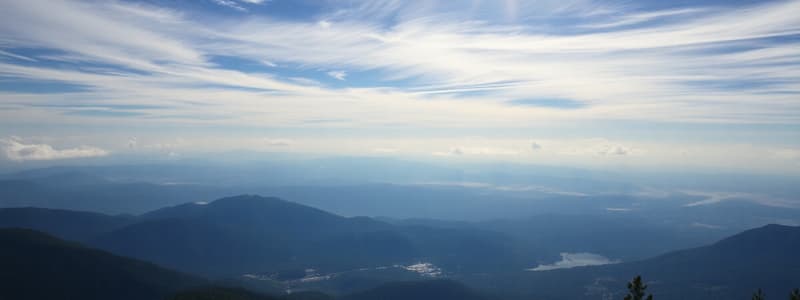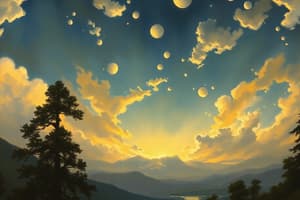Podcast
Questions and Answers
Which of Earth's spheres is uniquely characterized as biotic?
Which of Earth's spheres is uniquely characterized as biotic?
- Biosphere (correct)
- Atmosphere
- Geosphere
- Hydrosphere
Considering the composition of Earth's atmosphere, which gas constitutes the highest percentage?
Considering the composition of Earth's atmosphere, which gas constitutes the highest percentage?
- Oxygen
- Nitrogen (correct)
- Argon
- Other gases
If you were to move upwards from the Earth's surface through the atmosphere, what is the correct order of the atmospheric layers you would encounter?
If you were to move upwards from the Earth's surface through the atmosphere, what is the correct order of the atmospheric layers you would encounter?
- Stratosphere, Troposphere, Thermosphere, Mesosphere, Exosphere
- Troposphere, Stratosphere, Mesosphere, Thermosphere, Exosphere (correct)
- Mesosphere, Thermosphere, Exosphere, Troposphere, Stratosphere
- Exosphere, Thermosphere, Mesosphere, Stratosphere, Troposphere
The ozone layer, located within the stratosphere, plays a critical role in protecting life on Earth. What is the primary function of the ozone layer?
The ozone layer, located within the stratosphere, plays a critical role in protecting life on Earth. What is the primary function of the ozone layer?
Which statement accurately describes a characteristic of the atmosphere as you move further away from the Earth's surface?
Which statement accurately describes a characteristic of the atmosphere as you move further away from the Earth's surface?
Which of the following characteristics demonstrates the interdependence between the biosphere and other Earth spheres?
Which of the following characteristics demonstrates the interdependence between the biosphere and other Earth spheres?
Considering the interactions between Earth's spheres, what is the most likely consequence of deforestation by humans?
Considering the interactions between Earth's spheres, what is the most likely consequence of deforestation by humans?
How might a volcanic eruption, which originates in the geosphere, directly impact the hydrosphere?
How might a volcanic eruption, which originates in the geosphere, directly impact the hydrosphere?
If a significant portion of glaciers within the hydrosphere melts due to climate change, which of the following outcomes is most likely?
If a significant portion of glaciers within the hydrosphere melts due to climate change, which of the following outcomes is most likely?
Organisms are found in the biosphere at a range of altitudes and depths. Based on the text, what is the approximate vertical range, from highest to lowest point, at which life can be found?
Organisms are found in the biosphere at a range of altitudes and depths. Based on the text, what is the approximate vertical range, from highest to lowest point, at which life can be found?
Flashcards
Atmosphere
Atmosphere
All air on Earth, extending up to 10,000 km above the surface.
Biosphere
Biosphere
All living things on Earth, including plants, animals, and microorganisms.
Geosphere
Geosphere
All solid land in Earth's crust.
Hydrosphere
Hydrosphere
Signup and view all the flashcards
Troposphere
Troposphere
Signup and view all the flashcards
Earth's Inner Core
Earth's Inner Core
Signup and view all the flashcards
Sphere Interconnection
Sphere Interconnection
Signup and view all the flashcards
Study Notes
- The Earth consists of four spheres: the atmosphere, biosphere, geosphere, and hydrosphere.
Atmosphere
- The atmosphere refers to all the air on Earth.
- Its name originates from the Greek word "atmos," meaning "vapor."
- It is abiotic, containing no living organisms.
- The atmosphere extends up to 10,000 kilometers above Earth's surface.
- It is the outermost layer composed of physical matter.
- The atmosphere is primarily composed of 78% nitrogen, 21% oxygen, 0.9% argon, and 0.1% other gases.
- There are five layers within the atmosphere: troposphere, stratosphere, mesosphere, thermosphere, and exosphere.
- The troposphere is the densest layer.
- Layers increase in temperature as they get further from Earth.
- The ozone layer, located in the stratosphere, blocks ultraviolet radiation.
Biosphere
- The biosphere encompasses all living things on Earth, including plants, animals, and microorganisms.
- Its name originates from the Greek word "bio," meaning "life."
- It is the only biotic sphere.
- Life is abundant on Earth, from microscopic organisms to large animals.
- It depends on the other three spheres for survival, needing water from the hydrosphere, oxygen from the atmosphere, and shelter from the geosphere.
- Most life is found on Earth's surface, but the biosphere extends 500 meters below the surface and 6 kilometers above sea level.
Geosphere
- The geosphere includes all solid land in Earth's crust.
- Its name originates from the Greek word "geo," meaning "earth."
- It is abiotic, and does not contain living organisms.
- It contains all solid rock and liquid molten rock.
- Rocks change states of matter due to extreme pressure closer to the center of Earth.
- The geosphere consists of four layers: the inner core, outer core, mantle, and crust.
- The inner core is the hottest layer, reaching about 6,000 degrees Celsius.
- The outer core is composed of liquid iron and nickel at 5,000 degrees Celsius.
- The mantle is made of rock, magnesium, and iron, with temperatures ranging from 871 to 4,000 degrees Celsius.
- The crust is the outermost layer, with a maximum temperature of 871 degrees Celsius.
Hydrosphere
- The hydrosphere contains all water on Earth.
- Its name originates from the Greek word "hydro," meaning "water."
- It is considered abiotic.
- Water is composed of two hydrogen atoms and one oxygen atom.
- Water exists in liquid, solid (glaciers, ice), and gaseous (water vapor) forms.
- Over 97.5% of Earth's water is in the oceans.
Interaction of Spheres
- The spheres interconnect and interact in many ways.
- Rain from the hydrosphere falls through the atmosphere and lands on the geosphere.
- This water can then be used by animals from the biosphere.
- Human actions, such as cutting down trees, can negatively impact the geosphere and biosphere.
Studying That Suits You
Use AI to generate personalized quizzes and flashcards to suit your learning preferences.
Description
Explore the atmosphere and biosphere, two of Earth's four spheres. The atmosphere contains all the air on Earth. The biosphere includes all living things. Learn about their composition, layers, and importance.




